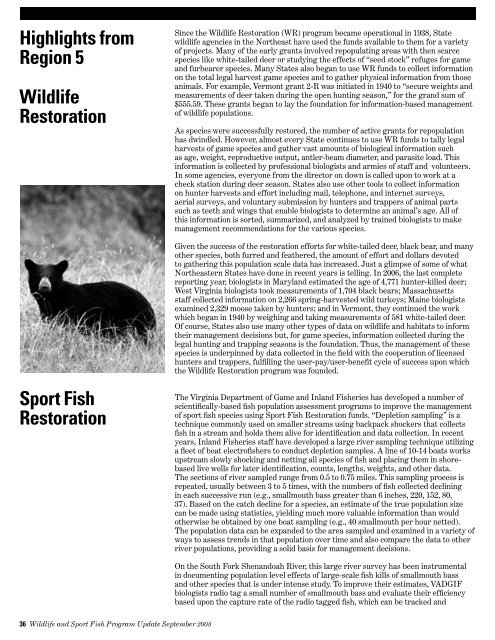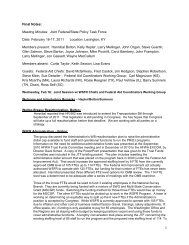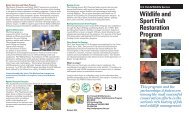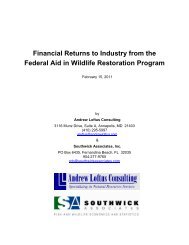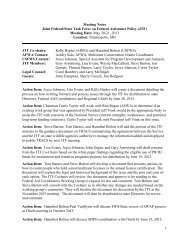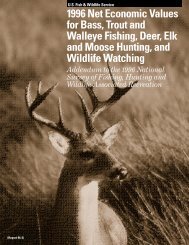Program Update - Wildlife and Sport Fish Restoration Program - U.S. ...
Program Update - Wildlife and Sport Fish Restoration Program - U.S. ...
Program Update - Wildlife and Sport Fish Restoration Program - U.S. ...
You also want an ePaper? Increase the reach of your titles
YUMPU automatically turns print PDFs into web optimized ePapers that Google loves.
Highlights from<br />
Region 5<br />
<strong>Wildlife</strong><br />
<strong>Restoration</strong><br />
Since the <strong>Wildlife</strong> <strong>Restoration</strong> (WR) program became operational in 1938, State<br />
wildlife agencies in the Northeast have used the funds available to them for a variety<br />
of projects. Many of the early grants involved repopulating areas with then scarce<br />
species like white-tailed deer or studying the effects of “seed stock” refuges for game<br />
<strong>and</strong> furbearer species. Many States also began to use WR funds to collect information<br />
on the total legal harvest game species <strong>and</strong> to gather physical information from those<br />
animals. For example, Vermont grant 2-R was initiated in 1940 to “secure weights <strong>and</strong><br />
measurements of deer taken during the open hunting season,” for the gr<strong>and</strong> sum of<br />
$555.59. These grants began to lay the foundation for information-based management<br />
of wildlife populations.<br />
As species were successfully restored, the number of active grants for repopulation<br />
has dwindled. However, almost every State continues to use WR funds to tally legal<br />
harvests of game species <strong>and</strong> gather vast amounts of biological information such<br />
as age, weight, reproductive output, antler-beam diameter, <strong>and</strong> parasite load. This<br />
information is collected by professional biologists <strong>and</strong> armies of staff <strong>and</strong> volunteers.<br />
In some agencies, everyone from the director on down is called upon to work at a<br />
check station during deer season. States also use other tools to collect information<br />
on hunter harvests <strong>and</strong> effort including mail, telephone, <strong>and</strong> internet surveys,<br />
aerial surveys, <strong>and</strong> voluntary submission by hunters <strong>and</strong> trappers of animal parts<br />
such as teeth <strong>and</strong> wings that enable biologists to determine an animal’s age. All of<br />
this information is sorted, summarized, <strong>and</strong> analyzed by trained biologists to make<br />
management recommendations for the various species.<br />
Given the success of the restoration efforts for white-tailed deer, black bear, <strong>and</strong> many<br />
other species, both furred <strong>and</strong> feathered, the amount of effort <strong>and</strong> dollars devoted<br />
to gathering this population scale data has increased. Just a glimpse of some of what<br />
Northeastern States have done in recent years is telling. In 2006, the last complete<br />
reporting year, biologists in Maryl<strong>and</strong> estimated the age of 4,771 hunter-killed deer;<br />
West Virginia biologists took measurements of 1,704 black bears; Massachusetts<br />
staff collected information on 2,266 spring-harvested wild turkeys; Maine biologists<br />
examined 2,329 moose taken by hunters; <strong>and</strong> in Vermont, they continued the work<br />
which began in 1940 by weighing <strong>and</strong> taking measurements of 581 white-tailed deer.<br />
Of course, States also use many other types of data on wildlife <strong>and</strong> habitats to inform<br />
their management decisions but, for game species, information collected during the<br />
legal hunting <strong>and</strong> trapping seasons is the foundation. Thus, the management of these<br />
species is underpinned by data collected in the field with the cooperation of licensed<br />
hunters <strong>and</strong> trappers, fulfilling the user-pay/user-benefit cycle of success upon which<br />
the <strong>Wildlife</strong> <strong>Restoration</strong> program was founded.<br />
<strong>Sport</strong> <strong>Fish</strong><br />
<strong>Restoration</strong><br />
The Virginia Department of Game <strong>and</strong> Inl<strong>and</strong> <strong>Fish</strong>eries has developed a number of<br />
scientifically-based fish population assessment programs to improve the management<br />
of sport fish species using <strong>Sport</strong> <strong>Fish</strong> <strong>Restoration</strong> funds. “Depletion sampling” is a<br />
technique commonly used on smaller streams using backpack shockers that collects<br />
fish in a stream <strong>and</strong> holds them alive for identification <strong>and</strong> data collection. In recent<br />
years, Inl<strong>and</strong> <strong>Fish</strong>eries staff have developed a large river sampling technique utilizing<br />
a fleet of boat electrofishers to conduct depletion samples. A line of 10-14 boats works<br />
upstream slowly shocking <strong>and</strong> netting all species of fish <strong>and</strong> placing them in shorebased<br />
live wells for later identification, counts, lengths, weights, <strong>and</strong> other data.<br />
The sections of river sampled range from 0.5 to 0.75 miles. This sampling process is<br />
repeated, usually between 3 to 5 times, with the numbers of fish collected declining<br />
in each successive run (e.g., smallmouth bass greater than 6 inches, 220, 152, 80,<br />
37). Based on the catch decline for a species, an estimate of the true population size<br />
can be made using statistics, yielding much more valuable information than would<br />
otherwise be obtained by one boat sampling (e.g., 40 smallmouth per hour netted).<br />
The population data can be exp<strong>and</strong>ed to the area sampled <strong>and</strong> examined in a variety of<br />
ways to assess trends in that population over time <strong>and</strong> also compare the data to other<br />
river populations, providing a solid basis for management decisions.<br />
On the South Fork Shen<strong>and</strong>oah River, this large river survey has been instrumental<br />
in documenting population level effects of large-scale fish kills of smallmouth bass<br />
<strong>and</strong> other species that is under intense study. To improve their estimates, VADGIF<br />
biologists radio tag a small number of smallmouth bass <strong>and</strong> evaluate their efficiency<br />
based upon the capture rate of the radio tagged fish, which can be tracked <strong>and</strong><br />
36 <strong>Wildlife</strong> <strong>and</strong> <strong>Sport</strong> <strong>Fish</strong> <strong>Program</strong> <strong>Update</strong> September 2008


